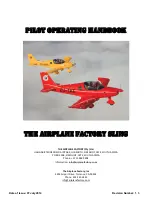
11
Please remember! The R-BUS is a tandem wing with the capacity for
great flights, but it must be handled correctly or it may cause serious
problems for the pilot and passenger.
We recommend learning to fly this wing under the guidance of a qualified
instructor.
4.1 DOUBLE STEERING SYSTEM
Double Steering System
The R-BUS has two brake lines: the main brake (conventional brake) and
the High Speed Tip (fixed to a separate handle on the riser). The High
Speed Tip gives the pilot the ability to turn without pulling the brakes,
thus avoiding deforming the profile and therefore preventing a decrease
in performance and speed.
High Speed Tip
The High Speed Tip on the R-BUS consists of a line with three
attachment points located at the wingtip. It enables the pilot to correct
the direction easily and accurately without using the main brake controls
and therefore, the performance of the wing is not affected.
Torque Compensator
The Torque Compensator is a very efficient tool to compensate for the
natural equal and opposite effect caused by engine inertia or torque. This
line can be adjusted or set according to the needs of the pilot.
4.2 FLYING IN TURBULENCE
The R-BUS has an excellent profile and is very robust and solid in these
situations. It is very stable in all conditions and has excellent passive flight
reactions, which makes it very safe in turbulent conditions.
All paragliders must be piloted for the prevailing conditions and the pilot is
the ultimate safety factor.
We recommend active flying in turbulent conditions, always taking
Summary of Contents for R-BUS
Page 1: ...USER S MANUAL R BUS...
Page 20: ...20 10 3 RISERS LAYOUT...
Page 21: ...21 10 4 LINE PLAN...






































